In this post, I’ll dive into HubSpot’s customer journey map and highlight some best practices you should consider when making one of your own. I’ll also share some customer journey map case studies that are sure to inspire. In this post, I’ll cover the following:
Table of Contents
- What is a customer journey map?
- HubSpot’s Customer Journey Map
- Customer Journey Map Best Practices
- Customer Journey Map Case Studies
- Wrapping Up The Customer Journey Map
What is a customer journey map?
A customer journey map is a visual representation of all the touchpoints a customer experiences — from interactions with sales, marketing, and service teams to website and social media visits.
Every customer’s journey will be unique. Some customers encounter an ad and convert immediately, while others, like me, bide their time, consider options, and interact with a brand multiple times before making a purchase decision. By tracking and analyzing customer interactions, marketers can understand and influence purchasing behavior.
How? By creating a Customer Journey Map — [Free Download].
Customer journey maps are crafted from the customer’s perspective, providing valuable insights into what drives conversion. 80% of customers consider their experiences with a company as important as the company’s products and services, so getting your customer journey map right is a top priority.
HubSpot’s Customer Journey Map
Before we jump into my team’s process, let’s look at the map we came up with.

While there are several ways to structure a map, we decided that a linear design would be best for HubSpot. We highlighted common customer experiences on a timeline and color-coded them to symbolize whether the situation was a pain point or a moment of delight. This format made our map easy to read and more actionable for other teams.
Another feature we had was testimonials. While not depicted in the visual above, we asked customers to provide feedback on their experience, categorized their results based on where they were in the customer’s journey, and then picked one that best summarized our customers’ perspective of that interaction. These stories connected the map back to our customers and created problems that felt more relevant and urgent to our employees.
Now that I’ve reviewed the structure and details of HubSpot’s map, let's discuss some best practices for creating one at your business.
Customer Journey Map Best Practices
1. Think about your design last.
When creating a customer journey map, it is tempting to jump right into aesthetics and design. However, I’ve realized that it is essential to fully understand your data before worrying about visualization.
First, use Excel to organize customer interactions. Over time, a clear picture of the customer’s path will emerge. Only once you deeply understand the data behind the customer journey should you consider using software to transform your spreadsheet into a journey map.
Pro tip: Sketch and iterate quickly on customer journey map designs using paper or a whiteboard. Once your data narrative is clear, move on to a high-fidelity design.
2. Lean on qualitative data.
I was always under the impression that hard data and numbers reigned supreme, especially when it came to something like pitching a customer journey map. However, I’ve learned that high-quality qualitative feedback can be even more valuable when understanding the customer experience.
Testimonials and customer interviews tell a story that pure interaction data misses. In my work, I’ve found it insightful to focus on 10-15 customers and look for recurring experiential themes in their responses. Accordingly, I recommend prioritizing high-quality qualitative feedback over simply collecting a large amount of data.
Pro tip: Record and transcribe customer interviews, and then use AI sentiment analysis tools to understand key themes and emotions.
3. Survey internal and external stakeholders.
While a customer journey map is based heavily on customer feedback, this information only provides one side of the story. If you rely solely on customer feedback, you might overlook how your internal teams influence customer interactions. Accordingly, I recommend interviewing internal and external stakeholders to get the most precise picture of the customer journey.
For our map, we hosted customer journey map workshops called “Touchpoints.” These 90-minute sessions, which included employees from all over the organization, highlighted instances where HubSpot influenced the customer experience. Any time employees generated a customer interaction via phone, email, or in person, that moment was recorded and labeled as a touchpoint. The image below shows how these meetings were set up.
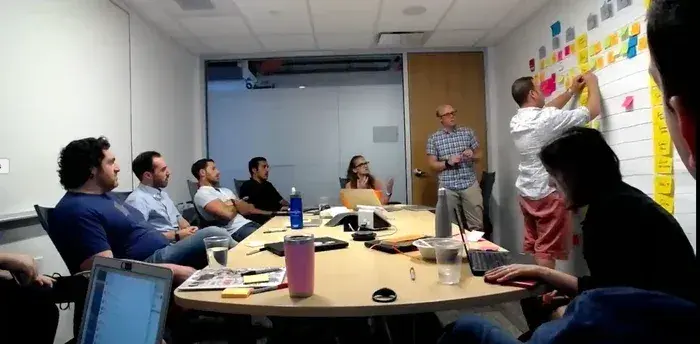
This revealed a variety of inconsistencies in our communication with customers. By bringing together representatives from each department, we addressed issues affecting the business and created a more consistent user experience.
Pro tip: Encourage collaboration between distinct teams, such as Support and Sales, so that each can uncover insights about the customer journey that they had not previously encountered.
4. Be aware of bias.
I’ve discovered that personal bias can distort findings. When providing feedback, customers might give unexpected answers or dodge the truth to avoid hurting people’s feelings at a brand they care about. To create an accurate customer journey map, I recommend implementing safeguards to prevent undue influence on customer feedback. Here is an example of a template for customer journey interview questions designed to avoid bias in customer responses.
Pro tip: Treat customer interviews like conversations. Creating a casual environment will encourage customers to share honest positive and negative feedback, which is essential to crafting a comprehensive customer journey map.
5. Create buy-in.
In my experience working in groups, it’s tough to drive action unless everyone involved sees the value of a proposal. The same goes for creating a customer journey map. You’ll need buy-in from leadership and key teams to fuel the creation of a customer journey map that everyone can get behind.
To gain support from key stakeholders, I recommend sharing quick wins early and demonstrating key insights from your proposed customer journey map. Demonstrate how you believe your map will lead to immediate improvements to the customer experience and increased conversions.
Pro tip: Use case studies and customer success stories to illustrate the customer journey and get buy-in from key stakeholders.
6. Take your time.
Creating an effective customer journey map isn’t an overnight project. For example, setting up and conducting customer interviews can take months, especially if you are trying to find users who match specific criteria or customer profiles.
As much as I’d love to release a customer journey map as soon as possible, I’ve found that the best things in life take time. In addition to conducting customer interviews and collecting interaction data over time, you’ll also need to meet with internal teams to get them on board with your customer journey map. These things take time, especially when everyone has their quarterly goals to worry about. But don’t sweat it — creating a customer journey map is a marathon, not a sprint.
Pro tip: Schedule regular customer interview sessions (quarterly or semi-annually) to update your map as customer experiences and expectations change.
7. Start with a simple adoption path.
For many businesses, the customer journey isn’t straightforward. Take my company, for example. I play bass in a touring band called Juice. There are many ways for someone to become a Juice fan (customer). They could catch us at a show, stumble upon one of our songs via TikTok or a Spotify playlist, or come to us via a friend’s recommendation. There’s no right or wrong path on the customer journey, but some have more steps than others.
When creating your customer journey map, focus on one customer persona and outline their most straightforward path to conversion. If you try to outline your entire customer base in one fell swoop, your map will be too vague to be of real value.
Pro tip: Focus first on the most critical touchpoints that drive conversions for your brand. For example, if most of your sales come through social media, focus on that pathway before integrating more complex interactions.
8. Make more than one customer journey map.
One single map can’t capture the entirety of your diverse customer base. Instead, you’ll want to create a map for each of your customer personas. I recommend starting with your core persona to make your first customer journey map. From there, you can expand to create additional maps for the rest of your diverse buyer personas.
Pro tip: Once you’ve created your first customer journey map, use it as a template to create maps for the rest of your personas. This way, you won’t have to start again from scratch.
9. Present your map.
After finalizing your customer journey map, it’s time to share it broadly across your organization.
In our case, we wanted to share it with leaders across HubSpot. Since we didn’t have quantitative data, we presented it by playing audio snippets from our customer interviews. These clips humanized the problems highlighted on the map and connected our conclusions to our customers’ feedback. Once employees heard firsthand feedback, the map felt more relevant to our company’s goals.
Pro tip: Remember, it’s all about the customer. When you present your customer journey map, emphasize how it can help meet customer needs, improve customer interactions, and strengthen your customer-centric culture.
If you’re excited to start this process at your company, learn how to create a customer journey map.
Customer Journey Map Case Studies
1. Starbucks
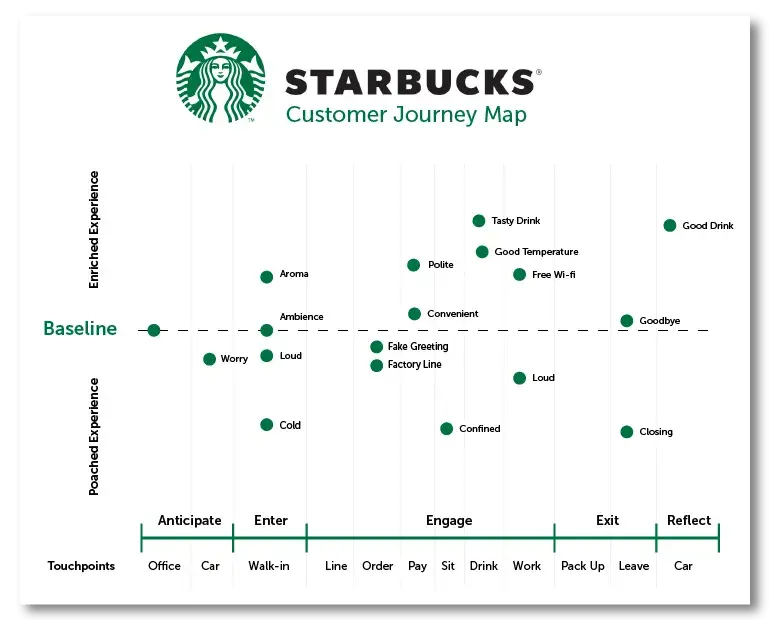
America’s favorite coffee shop didn’t become so dominant by accident. Starbucks closely analyzed the customer journey to elevate the in-store experience and continually delight customers.
By mapping out the customer journey, Starbucks discovered that long wait times were a significant pain point for customers. To address this, they leaned into mobile orders via the Starbucks app, enabling customers to order and pay ahead of time. This simple solution reduces wait times, enhances convenience, and boosts customer loyalty.
What I like: Starbucks’ customer journey map uses a simple timeline to show customers’ touchpoints as they get their coffee. I like that the map considers the steps before and after entering the store and highlights specific adjectives and traits that define an enhanced experience at each customer journey stage.
2. Spotify
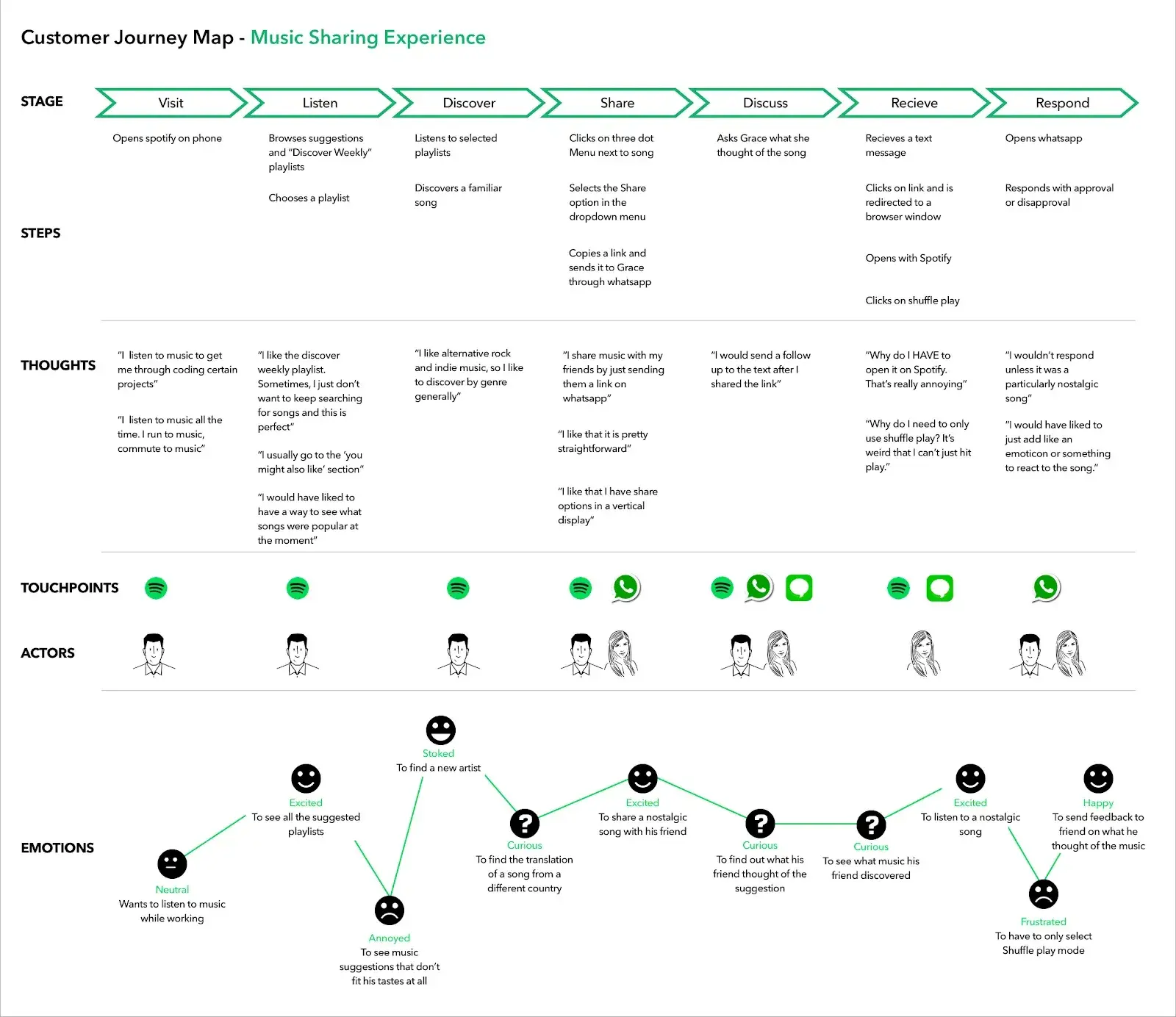
When Spotify, one of the world’s most popular music streaming services, sought to enhance its customer experience, it employed customer journey mapping.
The customer journey map above focuses on sharing music with a friend as the end conversion. It details each step a listener takes, from opening the Spotify app, listening, discovering related songs, sending a song to a friend, and the following discussion.
Based on its insights into the customer journey map, Spotify identified pain points in the music-sharing experience, which mainly revolve around personalization and reducing customer effort.
What I like: Spotify lists potential thoughts customers might have at each customer journey stage. This puts you in the headspace of an individual user, and it is supported by an emotional timeline that visualizes the pain points and pleasures of finding and sharing new music.
3. TSA PreCheck
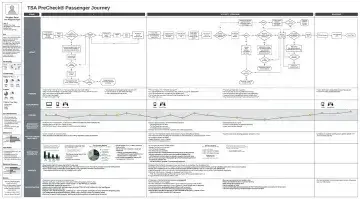
TSA and the Department of Homeland Security (DHS) set out to improve the TSA PreCheck experience for passengers (customers). However, they realized that they lacked a complete understanding of the entire PreCheck airport experience. So, they decided to create a customer journey map to visualize customer needs, pain points, and all the interactions that passengers have with TSA employees throughout their PreCheck experience.
The first step was to host a discovery session with TSA customer service employees to identify every touchpoint and discuss challenges to consider when attempting to improve customer experience. They also created a customer persona to humanize the passenger experience and foster empathy for customer needs. In addition, members of the DHS customer experience team provided their own first-hand experiences using TSA PreCheck to bolster customer data.
The result? TSA found the customer journey map to be a valuable tool for brainstorming solutions to common passenger pain points and understanding customer needs. I don’t know what specific solutions the TSA implemented based on the findings from their journey map, but I have breezed through security during every airport visit in recent memory.
What I like: I like that DHS CX team members contributed their qualitative data to the creation of the customer journey map. As customer experience professionals, I’m sure the data they provided was highly detailed and instrumental in building their customer journey map.
4. IKEA
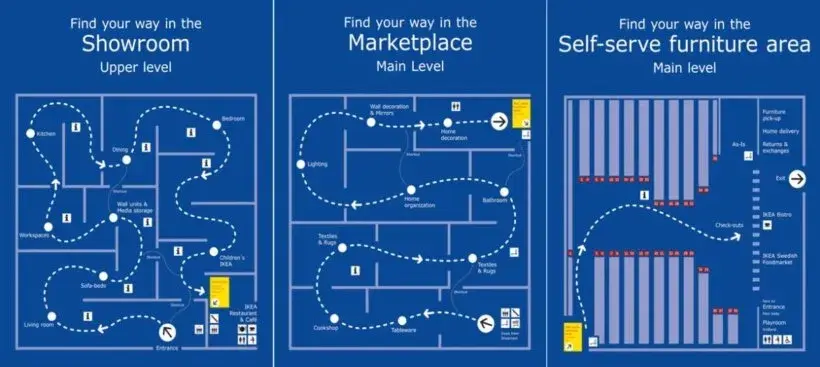
I love Ikea and their meatballs as much as the next guy, but have you ever wandered through one of their stores and felt like you were navigating an enchanted hedge maze — one that magically makes you part ways with your money? Well, that’s by design.
The traditional digital approach to customer journey mapping focuses on reducing customer effort and seamlessly flowing customers down the conversion pipeline. In contrast, IKEA’s in-store layout serves as a practical customer journey map, showcasing how shoppers are deliberately guided through a winding path that maximizes product exposure and encourages additional purchases.
What I like: IKEA’s map highlights the difference between customer journeys in physical and digital spaces. I find it interesting that IKEA creates an immersive (and somewhat confusing) customer experience, and yet I always walk away feeling good about my interactions with the brand.
Wrapping Up The Customer Journey Map
Working on this piece inspired me to think more critically about my interactions with brands in my daily life. It’s interesting to think that all my little touchpoints, like opening an email, visiting a website, or viewing a social media post, are part of a story that details my relationship with a brand.
As a customer, I might take these interactions for granted, but as a business owner, understanding and anticipating these customer interactions is critical.
Customer journey maps can help you meet customer needs by allowing you to understand and curate precisely what customers experience when interacting with your business. However, remember that customers, markets, and your business will change. So, keeping your customer journey map updated is essential to staying competitive in a market where customers expect high-quality, personalized experiences.
Editor's note: This post was originally published in October 2019 and has been updated for comprehensiveness.


.webp)
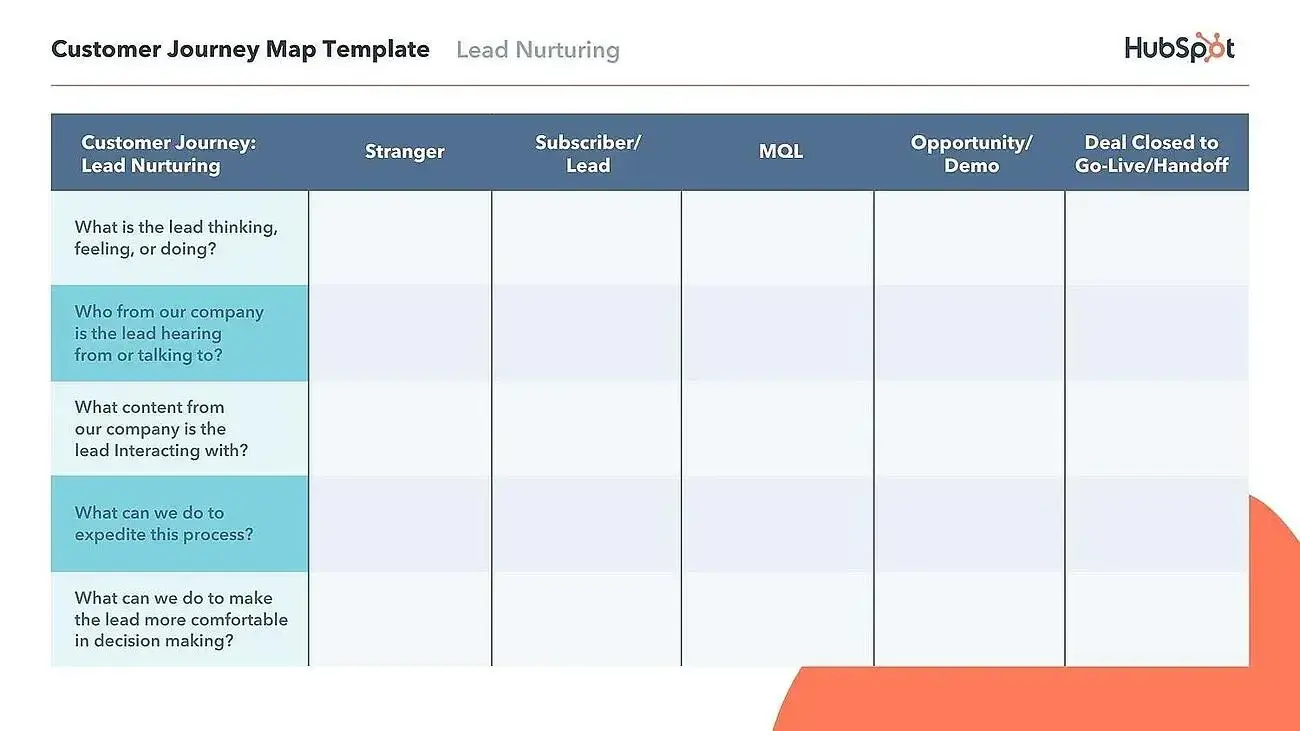



![What is a customer journey map? The complete overview [examples + templates]](https://53.fs1.hubspotusercontent-na1.net/hubfs/53/%5BUse-Oct-08-2025-10-53-10-8746-PM.webp)
![Predicting Customer Behavior and AI: My Journey to Understanding the Customer Mind [+ Pro Tips]](https://53.fs1.hubspotusercontent-na1.net/hubfs/53/predicting-customer-behavior-1-20241119-9776241.webp)

![How to Create a Customer Experience Map [Free Templates]](https://53.fs1.hubspotusercontent-na1.net/hubfs/53/customer-experience-map.jpg)